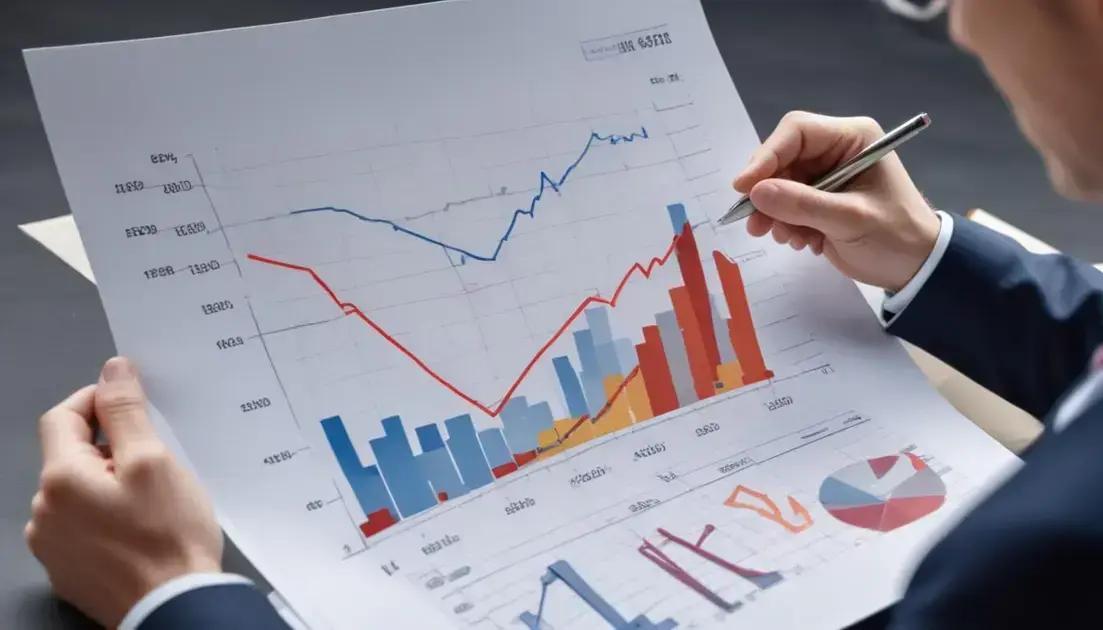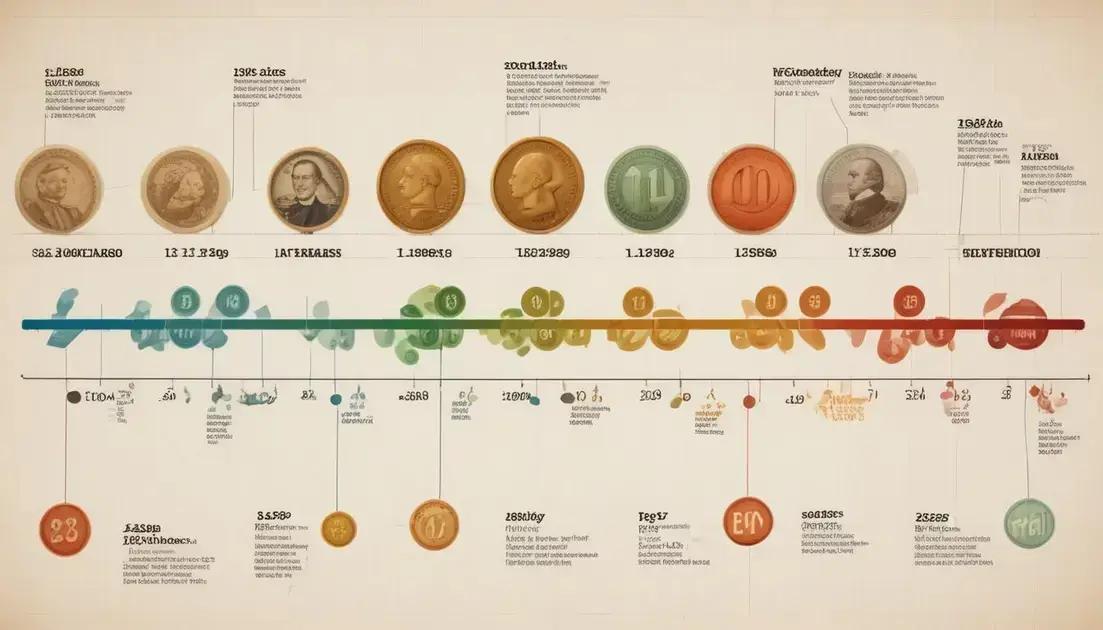Inflation trends: what they mean for your future

Anúncios
Inflation trends refer to the rate at which prices for goods and services rise, impacting purchasing power and shaping financial decisions; understanding these trends helps individuals protect their finances through strategic investments and budgeting.
Inflation trends significantly affect our daily lives, from the cost of groceries to housing prices. Have you noticed how prices keep creeping up? Let’s explore what’s behind these trends and what they could mean for you.
Anúncios
Understanding inflation and its impact
To truly grasp the concept of inflation, we first need to understand what it means. In simple terms, inflation refers to the rate at which the general level of prices for goods and services rises, leading to a decrease in purchasing power. This essential economic indicator influences everything from the prices we pay at the grocery store to the interest rates on loans.
What Causes Inflation?
Several factors can drive inflation rates up or down. For instance, when demand exceeds supply, prices tend to rise. This phenomenon is known as demand-pull inflation. Additionally, cost-push inflation occurs when production costs increase, leading to higher prices for consumers.
Anúncios
- Demand-pull inflation: Increased consumer demand.
- Cost-push inflation: Rising production costs.
- Built-in inflation: Wages increase, prompting higher prices.
Understanding these causes helps individuals navigate the economic landscape. Another critical component is how inflation impacts everyday life. When inflation is high, the money we have buys less than it used to. For example, a loaf of bread that costs $2 today might cost $2.50 next year if inflation continues to rise. This subtle change can greatly affect budget planning.
The Effects of Inflation on Savings
Inflation doesn’t just influence prices; it also impacts savings. For those keeping money in a traditional savings account, inflation diminishes what those savings can buy over time. It’s essential to consider investment options that can potentially outpace inflation, like stocks or real estate.
Additionally, as inflation rises, central banks may increase interest rates to control it. Higher interest rates mean higher borrowing costs, which can slow down economic growth. This creates a complex relationship where inflation not only impacts consumers’ pockets but also affects the wider economy.
Key drivers of inflation trends
Understanding the key drivers of inflation trends is crucial for anyone looking to make sense of economic changes. Various factors contribute to the rise or fall of inflation, affecting our purchasing power and financial decisions.
Demand and Supply Factors
One significant driver of inflation is the balance between demand and supply in the market. When demand for products outstrips supply, prices tend to rise. This scenario often leads to what economists call demand-pull inflation. Conversely, when there is an oversupply of goods, prices can stabilize or even decrease.
- Increased consumer spending can drive up demand.
- Supply chain disruptions can limit the availability of goods.
- Shifts in consumer preferences can also affect demand.
Another critical factor is the cost of production. As production costs increase due to higher wages or raw material prices, companies often pass those costs onto consumers, resulting in cost-push inflation. Fluctuations in energy prices or disruptions in supply chains can significantly impact these costs.
Monetary Policy
Central banks also play a pivotal role in influencing inflation through monetary policy. By adjusting interest rates, they can control the money supply in the economy. Lower interest rates generally encourage borrowing and spending, potentially increasing inflation. Conversely, higher interest rates may suppress spending and help control inflation.
Additionally, inflation expectations can influence actual inflation. If consumers and businesses expect prices to rise, they may adjust their behavior accordingly, which can create a self-fulfilling prophecy. These expectations often rely on past experiences with inflation, making it crucial to stay informed about economic trends.
Historical context of inflation changes

Understanding the historical context of inflation changes is essential to grasp how economic trends shape our lives. Over time, economies have experienced varying inflation rates, influenced by numerous factors such as wars, economic policies, and global events.
Inflation in the 20th Century
During the 20th century, many countries faced dramatic inflation changes. The Great Depression of the 1930s saw severe deflation in some areas, where prices fell drastically. However, post-World War II, numerous nations experienced increased inflation as economies rebuilt and consumer demand surged.
- Post-war economic boom led to rising prices.
- Government spending helped stimulate demand.
- Increased production costs drove prices up.
The 1970s are another critical period in inflation history. Known as the era of stagflation, many developed nations faced high inflation alongside stagnant economic growth. This period was triggered by oil crises and changes in monetary policy.
Inflation in Recent Years
In the 21st century, inflation trends have varied significantly. The 2008 financial crisis led to deflationary pressures, as consumer spending decreased sharply. However, by the 2010s, many economies saw a rebound, with inflation rates rising slowly.
More recently, the COVID-19 pandemic created disruptions in supply chains, contributing to rising prices for many goods and services. As economies reopened, pent-up consumer demand further fueled inflation. These historical changes illustrate how interconnected global events and local policies can shape inflation trends.
How to protect your finances against inflation
Protecting your finances against inflation requires strategic planning and smart choices. With rising prices impacting purchasing power, it’s essential to understand how to keep your savings intact.
Invest in Assets
One effective way to combat inflation is by investing in assets that tend to appreciate in value. Historically, stocks and real estate have been solid options for long-term growth. These investments can often outpace inflation, allowing your money to grow over time.
- Consider investing in stock markets to benefit from long-term growth.
- Real estate can provide both income and appreciation.
- Look into commodities like gold and silver, which can act as a hedge against inflation.
Additionally, diversifying your investments can reduce risks associated with inflation. By spreading your money across different asset classes, you enhance your chances of maintaining financial stability.
Review Your Budget
Another critical step in protecting your finances is to regularly review your budget. As prices change, your spending patterns may need adjustments. Keeping track of where your money goes helps identify areas where you can cut back.
Consider prioritizing essential expenses and reviewing discretionary spending. This practice of budgeting ensures you can manage rising costs without straining your finances. Furthermore, building an emergency fund can provide a safety net during uncertain economic times.
Lastly, consider utilizing inflation-linked savings accounts that offer interest rates indexed to inflation rates. This ensures that your savings maintain their purchasing power over time. With careful planning and informed decisions, you can better navigate the challenges presented by inflation.
Future predictions for inflation trends
Future predictions for inflation trends can help us anticipate changes in the economy and prepare accordingly. Many economists analyze various indicators to understand how inflation may behave in the coming years.
Economic Indicators
Key indicators such as the unemployment rate and consumer spending habits play a significant role in forecasting inflation. Generally, low unemployment rates can lead to higher wages, which can drive up prices. When people have jobs, they tend to spend more, increasing demand for goods and services.
- Watch for changes in consumer confidence, as it can signal future spending.
- Interest rates set by central banks also influence inflation expectations.
- Global supply chain disruptions can impact the availability of goods, affecting price levels.
Many analysts also look at commodity prices, particularly oil and food, as essential components in predicting inflation. An increase in the costs of these commodities can lead to broader inflationary pressures across the economy.
Inflation Forecast Models
Inflation forecast models utilize historical data to predict future trends. These models often take into account factors like government policy, market conditions, and international economic developments. An increase in government spending can stimulate the economy but may also lead to inflation if not managed correctly.
It is also important to note the potential for long-term inflation trends. If inflation remains consistently above target rates, it may lead to significant changes in monetary policy. Central banks may raise interest rates to control inflation, which could slow down economic growth but stabilize prices.
Understanding these factors is vital as we look ahead. By staying informed about economic shifts, we can better prepare for potential changes in inflation and make more strategic financial decisions.
In summary, understanding inflation trends is essential for making informed financial decisions. By exploring the causes and effects of inflation, as well as historical contexts, we can navigate the ongoing changes in the economy. Planning and protecting our finances through smart investments and budgeting helps us face future challenges. Staying aware of predictions and economic indicators allows us to adapt effectively to whatever lies ahead. Being proactive is the key to maintaining financial stability, even in uncertain times.
FAQ – Understanding Inflation Trends
What causes inflation in the economy?
Inflation can be driven by various factors, including increased demand for goods and services, rising production costs, and changes in government monetary policy.
How can I protect my finances from inflation?
To protect your finances, consider investing in assets that appreciate over time, such as stocks or real estate, and regularly review your budget.
What are the key indicators of future inflation trends?
Key indicators include unemployment rates, consumer spending habits, commodity prices, and monetary policy decisions made by central banks.
How does inflation affect my purchasing power?
As inflation rises, the value of money decreases, which means you will be able to purchase fewer goods and services with the same amount of money.






